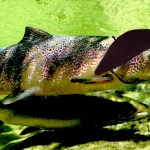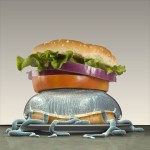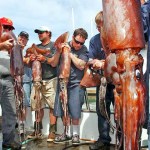
It's an New York Times oldie but goodie and I think one of the best graphics I've seen: savings versus debt of the average American household through the decades. I'd love to see one of these for fish catches in comparison to marine protected area (MPA) delegation.
Check out this fun and impromptu little Guilty Planet spot made by a friend of mine and founder of Avukado film and photography.
Many thanks to Mike HIrshfield at Oceana for sending along this little piece of good news: Atlantic salmon have returned to the Seine River. After having disappeared for nearly a century due to dams, overfishing, and pollution, hundreds of Atlantic salmon are swimming past the Eiffel Tower this year. The reason? Scientists say it's simple: cleaner water.
Bonjour! Salmon are back in the Seine...
Last month, Wal-Mart announced its plan to role out a sustainability index: a measure of how green its products are using a 15-question questionnaire (see the questions after the jump). You know that if the same store where a shrieking mob of holiday shoppers trampled an employee to death is talking this seriously about sustainability, then 1) we must really be in a pickle and 2) we must really be on the lookout for extreme greenwashing. Is Wal-Mart looking to improve its reputation? If so, is it doing so through deceptive or legitimate commitments? How can it reconcile profit with…
Cash for clunkers isn't leading to fewer carbon emissions--at least not in Germany.The New York Times reports today on the 50,000 cars (at least) in Germany that have been traded in for cash rebates to put toward new vehicles with lower emissions. The only problem is that those cars are making their way to Africa and Eastern Europe through an organized crime network (although by the sounds of the few safeguards in place to prevent this behavior, one can imagine that the system is not that organized). Congress recently extended the U.S. program that also offers rebates of $3,500 to $4,500…
We like tension. It makes for good stories. But it has been recognized that the fair and balanced approach to science news (and otherwise) can be detrimental. As Al Gore pointed out in An Inconvenient Truth, climate scientists, as represented by their peer-reviewed literature, hold a consensus view on the carbon crisis while the media continues to report skepticism.
Last week, an article was published in Science on Rebuilding Global Fisheries. The paper worked to reconcile views of marine ecologist Boris Worm and fisheries scientist Ray Hilborn (which Cornelia Dean at the New York Times…
The good news: I successfully defended my Ph.D. dissertation last Thursday. The bad news: I have not blogged for over a week now. My apologies for the long hiatus but please watch for new material very soon...
When Daniel Pauly first began talking about jellyfish burgers, he did so as an absurd metaphor. I blogged about it and, with the help of Sherman Lai, made this rudimentary burger:
Then, we upped the jellyfish burger ante when digital artist Dave Beck and I made this fancier version:
Meanwhile, jellyfish are on the rise everywhere and this summer the jumbo Nomura jellyfish are likely to again invade Japan.
And, on the flip side, jellyfish are now being made into all sorts of things, including, most recently, burgers. This Japanese website, translated by a friend who reads Japanese, is…
The American press is on suicide watch as Frank Rich declared earlier this year. With the fold of major print media outlets, like Rocky Mountain News, and the Seattle P-I and the bankruptcy of the chain that owns the Los Angeles Times and the Chicago Tribune, it seems that the predictions of the EPIC 2014 slideshow are right and that Frank Rich is, too.
So why would a photojournalist say: "As long I as I am alive, newspapers will be, too"?
Yet this was the battlecry of photographer Michel du Cille, who I had the pleasure to hear speak last Saturday at the Bellingham Visual Journalism…
In yet another case of jellyfish bloom and gloom, the gigantic Nomura jellyfish are back in the Sea of Japan for the third year since 2005. Check out the full story at CNN.
"It was marine algae."
This is the test result of the arctic goo spotted last week off the Alaska coast. According to an updated article in the Anchorage Daily News, the miles-long swath of goo has been identified as marine algae, although experts still don't understand why there is so much of it.
The blue-haired head south to La Jolla shores in the winter while the summertime is prone to a different migration. Jumbo Humboldt squid now make their way north. This weekend, San Diego's coast has been swarmed by schools of the 5-foot squid, which have upset divers and local beach goers. There is no mention in the recent articles of the reasons for the squid invasion -- likely a result of overfishing and warmer waters. But there was a nice example of the strong commodification of marine life with this article at the Huffington Post, which included in its title the phrase: Carnivorous…
The End of the Line, a documentary on global overfishing sparked by Charles Clover's book by the same title, has sparked many public conversations about global overfishing.
The latest discussion takes place today at SEED magazine, where several fisheries experts (many of them make appearances in the film) gave their impressions of the problem. I also provided a few recommendations: deal with pigs and chickens, eat local and leave seafood for survival, consider a seafood boycott, and agitate vertically rather than laterally.
Well, it may not be as hip and fresh as Kid Cudi's track Dat New New (pardon the unusual digression, but he is from Ohio...), but a 12-mile slick of arctic goo has hit the streets -- or at least the oceans -- around arctic Alaska. According to The Anchorage Daily News, the goo is organic (not oil, but some kind of organism) and one coast guard official said the following:
"It kind of has an odor; I can't describe it."
Arctic Goo: Dat New New.
As a way of counteracting some of the work by Environmental Working Group, the Sea Turtle Restoration Project, and Oceana to inform consumers about the health risks of consuming too much seafood, a new website was just launched called HowMuchFish.com, which tells you how much mercury-laden tuna, salmon, and shrimp you can 'safely' consume.
Although it might not be obvious at first glance, HowMuchFish.com is sponsored by the Center for Consumer Freedom -- "a nonprofit coalition of restaurants, food companies, and consumers working together to promote personal responsibility". Check out their…
With the shortages and environmental impacts of global meat (including ocean meat, aka seafood), perhaps we should be turning to introduced rodents and insects for future meals. We might be forced to turn to jellyfish, too. Check out the jellyfish burger that artist Dave Beck and I created -- now on display in a Discover gallery piece on whether Vermin is the Meat of the Future.
A neighborhood in Leicester, England had an entire YouTube channel dedicated to neighborhood issues, including catching "litter louts". As BoingBoing point out, this is a fine example of citizen surveillance. This case study also fits very nicely into our discussion of soft enforcement and sousveillence for conservation (it might also spawn a discussion about rights to privacy). The neighborhood has provided an email, and if someone knows the litterers in the videos they can email to alert the neighborhood management board.
Social-norms campaigns are intended to mitigate problem behaviors by conveying the message that problem behavior occurs with far less frequency than people think (e.g. teenage drinking). But for individuals who already abstain from the undesirable behavior, this can actually produce a boomerang effect (similar to the effect we discussed for the Crying Indian PSA) where people see that others are behaving in a certain way and actually do more of the undesired behavior. In other words, there is a tendency toward normalization.
In social messaging, therefore, it is important to build in…
McDonald's launched this ad for for their Filet-O-Fish sandwich this year (just in time for Lent). Their marketing strategy is an interesting one: a rare reminder that the fish you're eating comes from an animal that was once alive.
What if it were you hanging up on this wall?
If it were you in that sandwich, you wouldn't be laughing at all.
As part of the "Keep America Beautiful" campaign, "The Crying Indian" spot first aired in 1971 and was shown throughout the 1970s and 80s. It won two Clio Awards and was named one of the top 100 advertising campaigns of the 20th Century by Ad Age Magazine:
But research in psychology shows that this public service announcement (PSA) may not have been as effective as is widely believed.
Research by Bob Cialdini at Arizona State University reveals that the PSA's main message -- that we should not litter -- may have been undermined by showing how many people do in fact litter.
In his…




